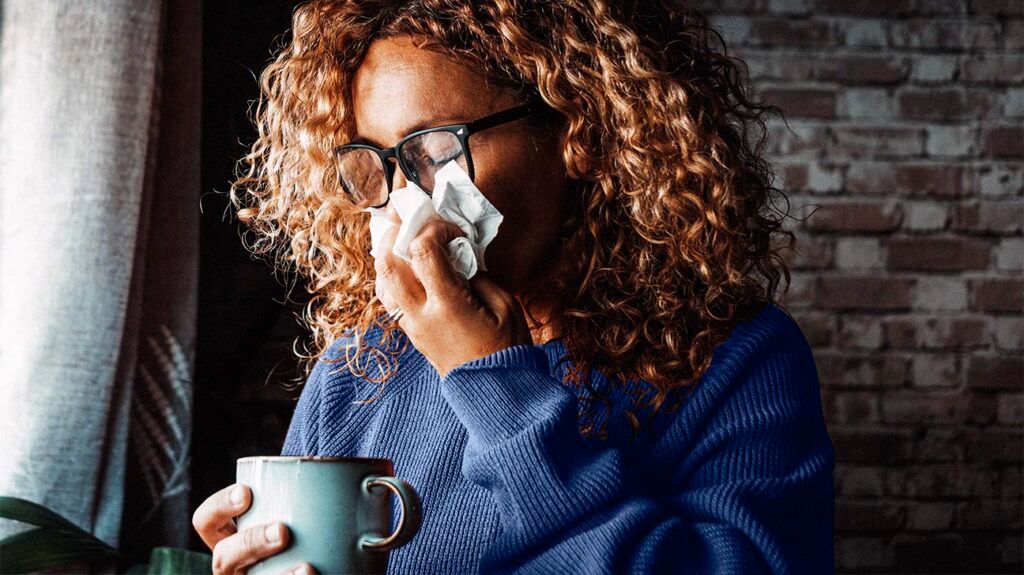HMPV is a frequent cause of respiratory infections. It usually causes mild symptoms similar to a common cold. However, people with risk factors such as asthma may experience more severe symptoms.
Human metapneumovirus (HMPV) is a common cause of respiratory infections. The virus typically causes upper respiratory tract infections, including the throat, mouth, and nose. In some cases, it can also cause lower respiratory tract symptoms, which affects the bronchi tubes (airways) and the lungs.
Typically, HMPV causes symptoms similar to a common cold. However, some people, such as those with asthma, may have an increased risk of complications that can lead to serious breathing problems.
This article examines HMPV, including its symptoms, causes, diagnosis, and treatment.

Since its discovery in 2001, doctors have identified HMPV as a leading cause of colds in children. For most people, HMPV does not cause serious symptoms. For people without complications, the infection causes symptoms similar to a cold lasting about 2–5 days.
Symptoms frequently affect the upper respiratory tract and may cause:
If the infection leads to a lower respiratory tract infection, it may cause symptoms such as:
- coughing
- shortness of breath
- wheezing
- fever
When the lower respiratory tract, which includes the airways and lungs, becomes infected, symptoms may become more severe. A lower respiratory tract infection in children can cause a flare-up of asthma symptoms, croup, and pneumonia. For example, about 5–16% of children who have an HMPV infection develop pneumonia.
Learn more about the stages of the common cold.
A person usually contracts HMPV after contact with someone who has the virus. HMPV is a negative-strand RNA virus in the same family as the respiratory syncytial virus (RSV).
Anyone can contract with HMPV. Like any virus, people with a compromised immune system have an increased risk of becoming sick. Some diseases, cancer treatments, and medications can weaken a person’s immune system.
Certain age groups are also at increased risk of developing complications and having severe symptoms. For instance, young children have an increased risk of serious disease.
According to a 2020 literature review, hospitalizations for HMPV are highest in children under 2 years. Also, about 50% of children requiring hospitalization have an underlying complex long-term medical condition, such as asthma.
HMPV can also cause more serious symptoms in adults. Risk factors for severe symptoms in both children and adults include having:
- an underlying lung disease, such as asthma and COPD
- a cardiac condition, such as congestive heart failure
- a compromised immune system
HMPV
- coughing
- sneezing
- talking
Transmission can also occur through physical contact. For instance, someone with HMPV may have respiratory secretions on their hands and touch something. If another individual touches the object and then touches their nose, mouth, or eyes, they may contract the virus.
Usually, symptoms develop
According to the American Lung Association, HMPV circulates most often during the winter and spring months in the United States. However, a person can contract it at any time of the year.
Doctors do not always identify the exact respiratory virus responsible for upper or lower respiratory tract infections. However, they
Doctors may also perform a physical exam and take a full medical history. Sometimes, the doctor may confirm a diagnosis of HMPV through a nasopharyngeal swab. This involves inserting a swab into the nose and back of the throat to collect samples of secretions to test for the virus.
Not everyone with HMPV requires medical treatment. Treatment aims to reduce symptoms and make someone more comfortable. Treatment typically
- over-the-counter (OTC) fever-reducing medication such as acetaminophen
- decongestants
- inhalers, such as bronchodilators, to ease wheezing
- getting plenty of rest
People with severe symptoms may require supportive treatment, such as:
- oxygen therapy
- intravenous fluids
- steroids for lung inflammation
- antibiotics for a secondary bacterial infection
Prevention of the virus includes avoiding contact with someone with an infection. Additional steps to take may include:
- frequent handwashing
- getting enough sleep to keep the immune system strong
- avoiding sharing items, such as eating utensils, glasses, and towels
HMPV frequently causes upper and lower respiratory infections. It is one of the most common causes of a cold. Symptoms often include sore throat, congestion, and runny nose.
Anyone can contract HMPV. Most people do not develop serious complications. But in people with risk factors, such as underlying lung or heart disease, complications can occur, including pneumonia.
Treatment, including OTC fever-reducing medication and decongestants, aims to ease symptoms until they resolve.
